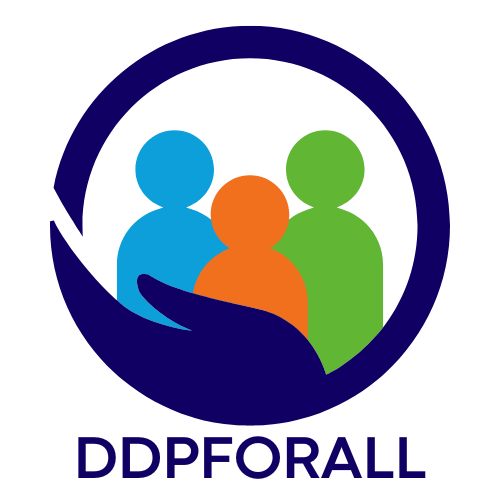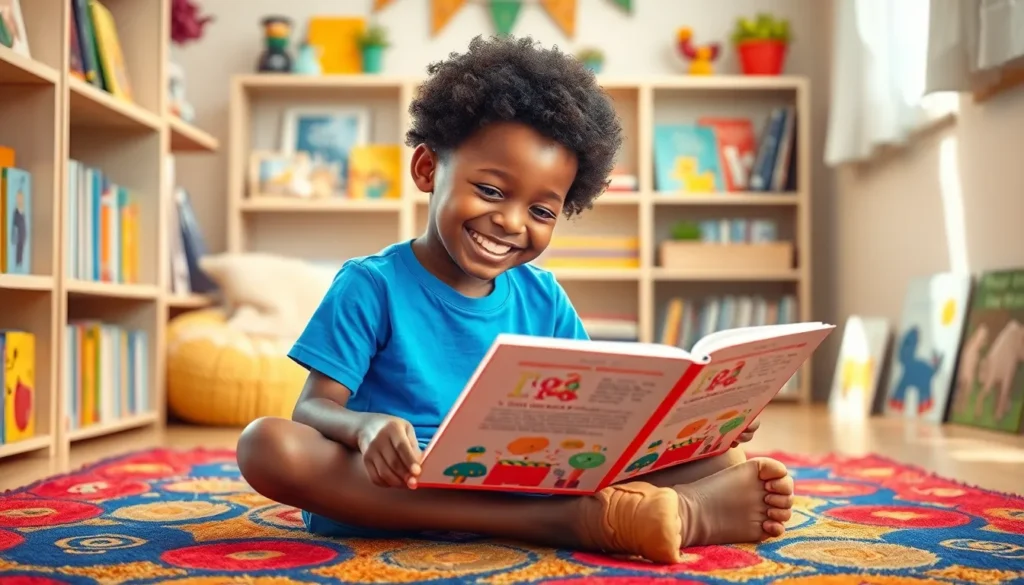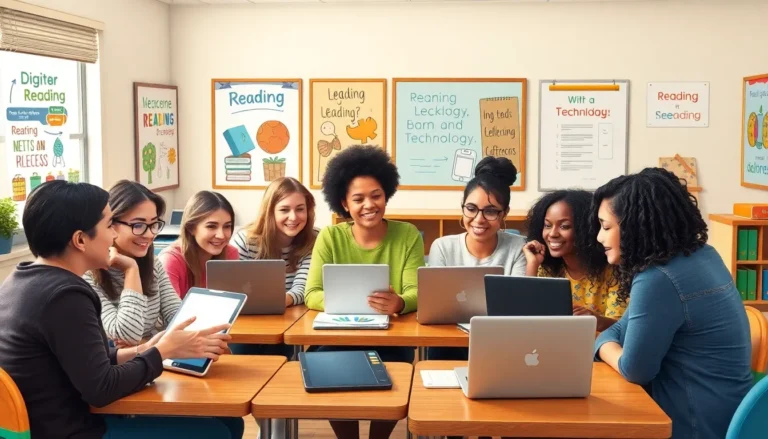Table of Contents
ToggleReading isn’t just a skill; it’s a superpower waiting to be unlocked! From deciphering the mysterious squiggles of letters to diving into the depths of epic novels, everyone travels through the four stages of reading development. Each stage is like leveling up in a video game, complete with challenges, rewards, and a few plot twists along the way.
Overview of the 4 Stages of Reading Development
Reading development consists of four clear stages, each marking a significant growth in a child’s ability to read. The first stage, known as Emergent Literacy, typically occurs from birth to age five. During this phase, children develop an understanding of the basics of print and oral language. Learning to recognize letters and sounds forms the foundation for future reading skills.
The second stage is Early Reading, generally between ages six and seven. At this point, children begin to blend sounds into words. They start reading simple texts and develop greater confidence in their reading abilities. Progress in vocabulary occurs rapidly, allowing for a more immersive reading experience.
Transitioning to the third stage, Transitional Reading emerges around ages eight to ten. Readers at this stage become more fluent, tackling more complex texts. Comprehension skills sharpen, enabling readers to analyze and synthesize information. This stage fosters a deeper appreciation for story and structure.
The final stage, called Fluent Reading, usually occurs from ages eleven and up. Individuals at this level read with speed and accuracy, often engaging with various genres. Critical thinking skills enhance, allowing readers to form personal interpretations of texts. Profound understanding of context and nuance characterizes this stage of development.
These stages represent a pathway to becoming a proficient reader, essential for academic success and lifelong learning. Each stage builds upon the last, contributing to a comprehensive literacy journey.
Stage 1: Emergent Literacy

Emergent literacy is crucial for laying the groundwork for future reading skills in children aged birth to five. This stage highlights the fundamental understanding of print and oral language.
Characteristics of Emergent Readers
Emergent readers display several key characteristics. They often recognize some letters and can associate sounds with those letters. Many show interest in books and enjoy listening to stories. Visual cues become significant, as children start identifying images that correlate with text. They may engage in pretend reading, mimicking the act of reading aloud. Frequently, they use pictures to convey meaning, demonstrating an early stage of comprehension. Patterns in words also attract their attention, and they begin to grasp basic concepts of print, such as reading from left to right.
Activities to Foster Emergent Literacy
Engaging activities can significantly enhance emergent literacy. Reading aloud to children exposes them to language patterns and vocabulary. Picture books serve as effective tools for sparking their imagination while promoting word recognition. Singing songs and chanting rhymes helps them explore phonemic awareness and sound patterns. Providing access to various books allows children to experiment with words and concepts. Interactive games that include letters and sounds offer a playful approach to learning. Encouraging storytelling promotes their creativity and strengthens language skills, paving the way for more advanced reading abilities.
Stage 2: Early Reading
During the early reading stage, children ages six to seven begin developing essential reading skills. They start blending sounds into words and reading simple texts, gaining confidence and rapidly expanding vocabulary.
Key Skills Developed in Early Readers
Children develop several key skills during this stage. Phonemic awareness becomes crucial as they recognize sound patterns in words. Word recognition improves, enabling them to identify familiar words quickly. Comprehension skills also begin to strengthen; young readers engage with stories and recall details. Emerging decoding skills evolve, helping children sound out unfamiliar words. Interest in books grows, encouraging exploration of various texts. This combination of skills sets the foundation for future reading development.
Strategies to Support Early Reading
Supporting early reading involves engaging strategies for children. Reading aloud daily helps nurture a love for books and improves listening skills. Providing access to a range of simple texts encourages exploration and discovery. Interactive reading sessions promote discussions about stories, enhancing comprehension. Utilizing phonics games can make learning sounds enjoyable. Additionally, incorporating sight word activities builds confidence in word recognition. Each strategy supports children as they progress through this vital reading stage.
Stage 3: Transitional Reading
Transitional readers display notable advancements in their reading journey. These individuals strengthen their fluency and engage with more complex narratives, leading to enhanced comprehension.
Identifying Transitional Readers
Transitional readers typically range from ages eight to ten. They exhibit clarity in their reading, demonstrating a mix of decoding and comprehension skills. These readers begin to analyze characters and plots with greater depth. Key traits include the ability to read with expression and discuss story elements critically. Children showcase increased reading independence, often opting for chapter books and series that challenge their skills. Familiarity with diverse genres also emerges, reflecting their growing interests and abilities.
Techniques for Encouraging Transitional Reading
Encouraging transitional reading effectively involves strategic activities. Incorporating reading groups fosters collaboration and discussion among peers. Introducing a variety of texts enables readers to explore their preferences and expand vocabulary. Engaging in book discussions promotes critical thinking, asking questions about characters and themes. Encouraging readers to summarize chapters helps reinforce comprehension. Providing regular access to library visits cultivates a love for discovery and exploration in reading. These techniques not only support skill development but also enhance motivation and enthusiasm for reading.
Stage 4: Fluency and Independent Reading
Fluent reading signifies a reader’s ability to read smoothly, accurately, and with expression. Readers at this stage demonstrate confidence while engaging with various texts.
Traits of Fluent Readers
Fluent readers recognize words automatically, allowing them to focus on meaning and comprehension. Comprehension skills deepen as they connect ideas and themes across texts. These readers often express their understanding through discussion and analysis, showcasing critical thinking. Increased vocabulary enhances their reading experience, enabling them to tackle diverse genres. They also develop a personal reading style, often gravitating toward specific authors or topics that resonate with them.
Ways to Promote Independent Reading
Promoting independent reading cultivates a lifelong love for literature. Providing a rich selection of books is essential, allowing readers to choose texts that spark their interest. Establishing daily reading routines reinforces commitment, turning reading into an enjoyable habit. Encouraging book talks fosters enthusiasm and allows readers to share insights. Creating a cozy reading space adds to the overall experience, helping readers escape into their literary worlds.
Understanding the four stages of reading development is crucial for fostering a child’s literacy journey. Each stage builds on the previous one and offers unique opportunities for growth and engagement. By recognizing where a child is in their reading path, caregivers and educators can provide tailored support that enhances their skills and nurtures a love for reading.
Encouraging independent reading and creating a supportive environment are vital components in this process. As children progress through these stages, they not only become proficient readers but also develop critical thinking skills that will serve them throughout their lives. Embracing this journey can unlock the true superpower of reading, paving the way for academic success and a lifelong passion for literature.







